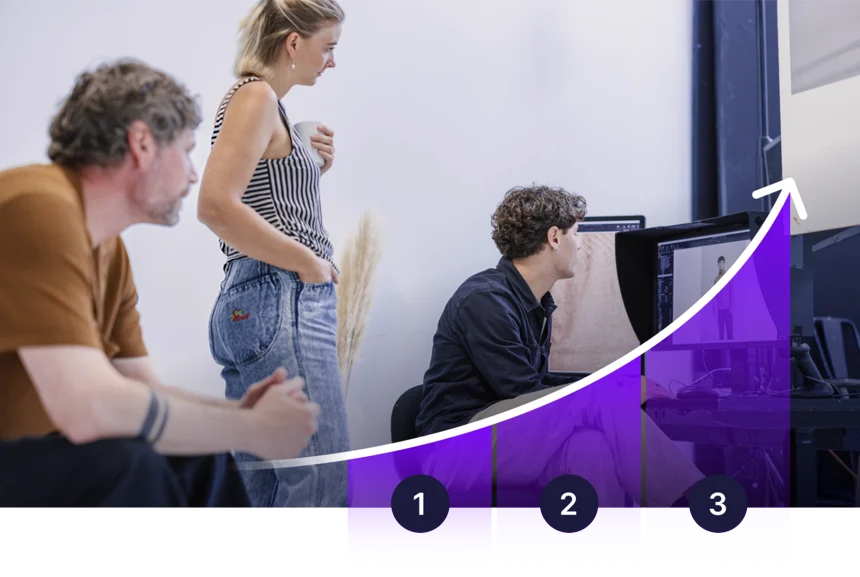Introducing the Creative Force Studio Maturity Model

For years, we at Creative Force have recognized the need for a standard methodology to objectively evaluate the maturity of a content creation studio's operations.
Many other professions and industries have well-established, industry-standard maturity models that allow them to quickly self-assess their current state, compare their operations with others in their industry, and provide actionable steps to achieve their next developmental milestone. Our industry has been lacking such a tool.
Rather than waiting for someone else to fill this gap, we decided to take on the challenge ourselves. We’re excited to introduce the Creative Force Studio Maturity Model—a comprehensive framework designed specifically for content studios.
Who Benefits from a Studio Maturity Model? Everyone in Our Industry!
We designed this model to help business executives, studio leaders, and creatives in the content production industry better understand the strengths and weaknesses of their creative operations and compare themselves with the rest of the industry. As part of our model, we also generate a customized Studio Maturity Report packed with advice—sourced from our internal industry experts—for how studios can further mature every area of their creative operations.
Ultimately, the goal of our Studio Maturity Model is to offer an objective assessment of a studio’s operations and to provide best practices for building stronger teams, increasing operational efficiency, and consistently producing high-quality content.
Developing the model was a great learning experience for our teams at Creative Force, and we believe it will provide equally valuable learning opportunities for your organizations. But before we delve into the details of the model, I want to share insights into its development process and some of the lessons we learned along the way.
The Studio Maturity Model Development Process
The process of defining our model involved some hard-hitting, foundational, and, at times, philosophical discussions about creative operations. What does underperforming, proficient, and great studio leadership look like? How do you define a healthy studio culture? What does it mean to be “successful” as a creative studio?
To formalize our thoughts, we first needed to decide on a structure for our model. We eventually settled on a three-stage model that describes creative studio operations developing from “Reactive” to “Managed and Sustainable” to “Optimized.” We broadly defined these levels of maturity as follows:
- Reactive Studios are chaotic. There is little (or very ineffective) studio leadership in place, various non-purpose-built tools (e.g., spreadsheets, PDFs, intranets) are cobbled together to manage assets, no production data is collected, and everything is handled in an ad-hoc manner.
- Managed and Sustainable Studios function well enough. Processes are followed but not optimized. Creative teams generally work in silos. Assets are produced on time, but there is no emphasis on capturing efficiency data or continuously improving processes.
- Optimized Studios are world-class content production operations. They feature strong leadership, automation enabled by great technology, a forward-thinking approach to creative operations, a proactive approach to challenges, and a culture of continuous improvement heavily informed by production data.
At a high level, this all sounded great. However, as we discussed further, we determined that it wasn't valuable to define an entire studio as, for example, “Reactive.” Studios are complex, and the different elements of a studio develop at different rates. A studio’s leadership might be “Reactive,” but their tech stack might be “Managed and Sustainable” or even “Optimized.” They might have great ways of working but collect little to no operational data.
For our model to be valuable, it became clear we needed to analyze a studio’s operations in greater detail. That's when we began breaking down content studio operations into seven foundational elements.

Evaluating Studios vs. Elements of a Studio
Recognizing that evaluating a studio’s overall maturity wouldn't provide the valuable insights we aimed to offer the industry, we needed to determine which core elements, when analyzed for their maturity, would most accurately represent the studio's overall performance.
We identified the following five foundational elements of a creative studio:
Studio Leadership
Is there effective leadership overseeing the entire content production process?
Team Collaboration
How well do team leaders (photography, post-production, etc.) work together? Are they siloed and unaware of the work happening upstream and downstream, or do they collaborate effectively as a cohesive team?
Technology
How optimized is the studio’s tech stack? Do operations rely solely on generic tools like spreadsheets and PDFs cobbled together, or do they leverage a well-integrated tech stack comprised of purpose-built hardware and software?
Ways of Working
How well-defined are the studio’s processes? To what extent has a culture of continuous improvement been instilled?
Production Quality
How consistently does the studio produce content to the expected level of quality?
Operational Insights
What data is collected and tracked on creative operations?
Integration with the Business
To what extent is the studio seen as a strategic partner that can impact the overall performance of the business?
Once we identified these foundational elements, our next step was to define what "Reactive," "Managed and Sustainable," and "Optimized" look like for each one. For example: what does Reactive, Managed & Sustainable, and Optimized team collaboration look like? What about a studio’s tech stack? Their ways of working? And so on for each of the seven studio elements.
In the end, we had seven rubrics defining each foundational element of a studio at all three levels of our model. That was great a start, but rubrics aren’t intuitive in terms of how a studio leader, for example, might use them to analyze their studio or to improve their studio operations.
We needed to turn those rubrics into an interactive tool. And so we created our Studio Maturity Self-Assessment.

Transforming a Rubric into a Tool
Our Studio Maturity Self-Assessment is a diagnostic tool for your studio. We ask you a few questions about your studio, and, based on your answers, we provide a full analysis of every foundational element of your creative ops covered by our model.The analysis of your studio comes in the form of a custom Studio Maturity Report. In it, we provide:
- An overall Studio Maturity Score
- A maturity score for the seven foundational elements of your studio
- Best practices to move each foundational element of your studio to the next maturity level in our model
Curious about your own studio? You can try it for yourself in less than 10-minutes here.
How to Use the Studio Maturity Self-Assessment
We’re incredibly excited about the insights and best practices these reports will provide to studio leaders, and we envision them being used in numerous ways.
The obvious use case for the Studio Maturity Self-Assessment is for studio leaders to take the questionnaire to evaluate the different elements of their studio and then discuss the report with their colleagues and other stakeholders in the studio.
For those who are bold enough to take things a step further, we suggest that studio leaders ask their team leaders and other critical stakeholders to take the assessment as well. Once everyone has their own analysis of your studio, gather everyone together to review your reports. Does everyone agree on the stage of your studio’s leadership? Do your team leaders think your ways of working are as optimized as you believe them to be? We see these reports as catalysts for valuable discussions between teams and a better understanding of the inner workings of the studio from various perspectives.
We believe the Studio Maturity Model is a significant step forward in providing our industry with formalized and standardized terminology for discussing content studio maturity. This model will not only facilitate conversations by offering a common vocabulary to identify strengths and areas for improvement but also provide objective assessments to help elevate the maturity of content studios across the industry.







